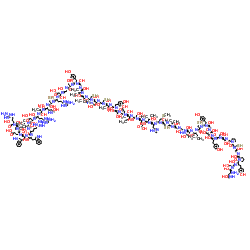Epidermal Growth Factor (from mouse)

Epidermal Growth Factor (from mouse) structure
|
Common Name | Epidermal Growth Factor (from mouse) | ||
|---|---|---|---|---|
| CAS Number | 62229-50-9 | Molecular Weight | 6045.66933999994 | |
| Density | N/A | Boiling Point | N/A | |
| Molecular Formula | C257H381N73O83S7 | Melting Point | N/A | |
| MSDS | Chinese USA | Flash Point | N/A | |
|
Paternal breed effects on expression of IGF-II, BAK1 and BCL2-L1 in bovine preimplantation embryos.
Zygote 23 , 712-21, (2015) The effects of the paternal breed on early embryo and later pre- and postnatal development are well documented. Several recent studies have suggested that such paternal effects may be mediated by the paternally induced epigenetic modifications during early em... |
|
|
Differential tolerance of 'pseudo-pathogenic' tryptophan residues in calcium-binding EGF domains of short fibulin proteins.
Exp. Eye Res. 130 , 66-72, (2015) An Arg345Trp (R345W) mutation in the last canonical calcium-binding epidermal growth factor (cbEGF) domain of fibulin-3 (F3) causes the rare macular dystrophy, Malattia Leventinese (ML). In cell culture studies, this mutation leads to inefficient F3 secretion... |
|
|
A re-assessment of long distance growth and connectivity of neural stem cells after severe spinal cord injury.
Exp. Neurol. 257 , 186-204, (2014) As part of the NIH "Facilities of Research Excellence-Spinal Cord Injury" project to support independent replication, we repeated key parts of a study reporting robust engraftment of neural stem cells (NSCs) treated with growth factors after complete spinal c... |
|
|
Self-renewal of hepatoblasts under chemically defined conditions by iterative growth factor and chemical screening.
Hepatology 61(1) , 337-47, (2015) Tissue-specific stem/progenitor cells are essential to mediate organogenesis and tissue homeostasis. In addition, these cells have attracted significant interest for their therapeutic potential. However, it remains challenging to expand most types of these ce... |
|
|
The Ah receptor regulates growth factor expression in head and neck squamous cell carcinoma cell lines.
Mol. Carcinog. 53(10) , 765-76, (2014) Previous studies in head and neck squamous cell carcinoma (HNSCC) cell lines have revealed that the Ah receptor (AHR) plays a significant role in mediating the "aggressive" phenotype of these cells, which includes enhanced inflammatory signaling (e.g., IL6) a... |
|
|
STIM1 phosphorylation triggered by epidermal growth factor mediates cell migration.
Biochim. Biophys. Acta 1853(1) , 233-43, (2015) STIM1 is a key regulator of store-operated calcium entry (SOCE), and therefore a mediator of Ca²⁺ entry-dependent cellular events. Phosphorylation of STIM1 at ERK1/2 target sites has been described as enhancing STIM1 activation during intracellular Ca²⁺ empty... |
|
|
Epidermal growth factor-induced cell death and radiosensitization in epidermal growth factor receptor-overexpressing cancer cell lines.
Anticancer Res. 35(1) , 245-53, (2015) The aim of the present study was to suggest potential mechanisms of epidermal growth factor (EGF)-induced cell death and radiosensitization in EGF receptor (EGFR)-overexpressing cancer cell lines.Two EGFR-overexpressing cancer cell lines (AMC-HN3, and A431), ... |
|
|
Changes in histone H3 lysine 36 methylation in porcine oocytes and preimplantation embryos.
PLoS ONE 9(6) , e100205, (2014) Histone H3 lysine 36 (H3K36) methylation is known to be associated with transcriptionally active genes, and is considered a genomic marker of active loci. To investigate the changes in H3K36 methylation in pig, we determined the mono-, di-, and tri-methylatio... |
|
|
A ROS/STAT3/HIF-1α signaling cascade mediates EGF-induced TWIST1 expression and prostate cancer cell invasion.
Prostate 74(5) , 528-36, (2014) Epidermal growth factor (EGF) has been known to induce epithelial-mesenchymal transition (EMT) and prostate cancer cell progression. However, a detailed underlying mechanism by which EGF induces EMT and prostate cancer cell progression remained to be answered... |
|
|
Specific ablation of Nampt in adult neural stem cells recapitulates their functional defects during aging.
EMBO J. 33(12) , 1321-40, (2014) Neural stem/progenitor cell (NSPC) proliferation and self-renewal, as well as insult-induced differentiation, decrease markedly with age. The molecular mechanisms responsible for these declines remain unclear. Here, we show that levels of NAD(+) and nicotinam... |